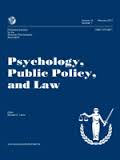 Law enforcement interviewers are generally aware of the difference between productive and counterproductive interviewing techniques, but standardization and implementation of these techniques are varied. This is the bottom line of a recently published article in Psychology, Public Policy, and Law journal. Below is a summary of the research and findings as well as a translation of this research into practice.
Law enforcement interviewers are generally aware of the difference between productive and counterproductive interviewing techniques, but standardization and implementation of these techniques are varied. This is the bottom line of a recently published article in Psychology, Public Policy, and Law journal. Below is a summary of the research and findings as well as a translation of this research into practice.
Featured Article | Psychology, Public Policy, and Law | 2015, Vol. 21, No. 3, 295-308
Productive and Counterproductive Interviewing Techniques: Do Law Enforcement Investigators Know the Difference?
Author
Dana Hirn Mueller, Florida International University
Nadja Schreiber Compo, Florida International University
Jacquelyn Molina, Florida International University
Alexarae Byron, Florida International University
Pamela S. Pimentel, Florida International University
Abstract
To date, there has been very little research examining the knowledge and perceived use of productive and counterproductive investigative interviewing techniques by U.S. law enforcement. The current study attempted to address this gap in the literature by presenting 212 U.S. law enforcement interviewers with video vignettes depicting productive and counterproductive interviewing techniques via an online survey. Interviewers were asked to identify each technique, report their use of each technique, and give their reasons for use and nonuse, respectively. In a subsequent section of the survey, participants were given the names and descriptions of the techniques previously shown in the videos and asked to rate the efficacy of each technique. Investigative interview training experience and knowledge of the National Institute of Justice guidelines for eyewitness evidence were also assessed. Results revealed that real-world interviewers report using productive techniques more frequently than counterproductive techniques and that the primary reason for using any interviewing technique is its perceived efficacy in gathering accurate and plentiful information. Participants also rated productive techniques as being m
Law enforcement, investigative interviewing, survey, trainingore effective at gathering accurate and plentiful information compared to counterproductive techniques. Of participants who reported receiving academy training after the National Institute of Justice guidelines were released, only 14.6% indicated that their interview training was based on those guidelines. Taken together, law enforcement investigators presented a general awareness that using productive witness interviewing techniques elicits more plentiful, accurate information from witnesses.
Keywords
Law enforcement, investigative interviewing, survey, training
Summary of the Research
“Despite its potential impact, very little research to date has examined the knowledge that U.S. law enforcement interviewers have regarding productive and counterproductive investigative interviewing techniques—an important piece in the research-to practitioner puzzle in U.S. witness interviewing. Specifically, it remains unclear whether investigators have basic knowledge about evidence-based productive and counterproductive interviewing techniques, whether investigators believe they use these techniques in their witness interviews, what type of opinions real-world interviewers have about the efficacy of these techniques to elicit a high quantity of accurate information from cooperative witnesses, and what type of witness interview they receive” (p.297). Thus, the current study distributed an electronicsurvey to U.S. law enforcement officers in all 50 states to assess knowledge and use of productive and counterproductive interviewing techniques for a cooperative witness.
“Eight clips portrayed eight individual productive interviewing techniques (rapport building, asking open-ended questions, using a nonverbal output option in the form of a sketch, giving an example of the level of detail expected from a witness, encouraging active witness participation, encouraging detailed responses, context reinstatement, and discouraging guessing) and eight clips portrayed eight individual counterproductive techniques (rapid-fire questions, negative rapport building, asking suggestive questions, asking multiple questions at once, asking only yes/no questions, environmental distractions, verbal interruptions, and asking complex questions). These techniques were chosen based on convergence between major interviewing guidelines including the NIJ guidelines and the CI, the centrality of these techniques in the investigative interviewing literature, and the ease of clearly portraying these techniques in a short video” (p. 298).
All participating officers indicated they had conducted at least 4 interviews with cooperative witnesses to a crime or other critical incident. Each technique was individually recorded with duration ranging from 15 seconds to 45 seconds. After viewing each clip, participants defined the technique and reported their use of that technique. In the next section, participants were given the names of each technique after the clip was viewed and rated its efficacy. Then, participants filled out a police academy/field training survey and were asked about specific training modalities.
“Encouragingly, out of those investigators who responded, most demonstrated a reasonably good understanding of and distinction between productive techniques and counterproductive techniques. Most interviewers were correct in identifying both productive and counterproductive techniques. Participants also reported frequently using productive techniques, which they found to be effective in eliciting accurate and plentiful accounts. These findings support the notion that a basic understanding of productive witness interviewing may have made its way to front-line interviewers. In contrast to actual police witness interviewing behavior police interviewers in our sample largely assessed productive techniques as beneficial and counterproductive techniques as ineffective.
Participants also tended to rate productive techniques as being more effective at eliciting both accurate and plentiful information compared with counterproductive techniques, although due to the low response rate in this section, an analysis was not performed to investigate whether this difference was statistically significant. It was also evident that although participants generally rated productive techniques as being more effective compared with counterproductive techniques, efficacy ratings for some productive techniques were low, which may indicate participants are not convinced of the efficacy of these techniques” (p. 305).
The results of this study suggest that while law enforcement officials generally know the difference between productive and counterproductive techniques and rate the efficacy of productive techniques as higher than those that are counterproductive, there seems to be a gap in-between training and implementation. For example, the NIJ guidelines do not seem to be distributed or mandated within the police force, yet they are research-based principles aimed to gather the most accurate information in an interview. Although increased training was negatively correlated with ratings of efficacy for counterproductive techniques, there was no relationship between training and ratings for productive techniques. Consequently, law enforcement officials may be aware of the least efficient interviewing techniques, but they may not be precisely using the most effective techniques (i.e. productive).
Translating Research into Practice
The current results further suggest that interview training is an important component in conveying productive interviewing knowledge. Specifically, the more academy training on witness interviewing respondents reportedly received, the less likely they were to rate counterproductive techniques as helpful in eliciting accurate and plentiful information. Our data also indicate that the more multifaceted the academy training interviewers reportedly received, the lower they rated counterproductive techniques in eliciting accurate information. Most participants further indicated that productive techniques were encouraged and counterproductive techniques were discouraged during training. These findings suggest that law enforcement interviewers have a general understanding of productive interviewing when presented with such techniques, especially when presented with the names and definitions of these techniques” (p. 305)
“Less encouraging was that real-world interviewers also reported using counterproductive techniques quite frequently. Across all counterproductive techniques, interviewers reported using these techniques in 42% of their interviews (albeit less often than productive techniques)… This specific finding further confirms the notion that law enforcement training may not fully distinguish between witness interview training and suspect interrogation training” (p. 305).
“Given that law enforcement practitioners report using techniques primarily because they believe these techniques to be effective, our findings imply that ways to encourage interviewers to implement productive techniques and avoid counterproductive techniques may be to emphasize the efficacy of productive techniques and the inefficacy of counterproductive techniques. Despite prior findings that real-world witness interviewers do not follow best practice interviewing guidelines, the present data suggest that the reason for this discrepancy may not necessarily lie in the lack of general knowledge about these techniques. Consequently, it may be the discrepancies between knowing what techniques to use and to avoid and actually implementing them. As such, the hurdles to implementation are an important next step to explore” (p. 306).
The authors suggest that continual supervision and feedback may establish long-term training effects. A redistribution of the NIJ guidelines to all precincts could also include “additional information about the extent to which research-based guidelines can deliver central investigative leads in an efficient, cost-effective manner, and could address why productive techniques were recommended and counterproductive techniques were discouraged” (p. 306). Lastly, a more collaborative approach should be taken when translating research into practice as researchers should work more closely with law enforcement training officials to establish a standardized, enforced, and maintained procedure for interviewing in each precinct.
Other Interesting Tidbits for Researchers and Clinicians
Gender may play a significant role when interviewing witnesses. The current study only used a female witness for filming each interviewing technique. Future studies may want to investigate any differences in reported use/ratings of efficiency for gender. An in-person study with law enforcement officials may also provide the researcher with more vigorous findings. Though the current study assessed cooperative witness interviews, the authors conjectured about a possible lack of distinction between a cooperative witness and suspect on the part of law enforcement. Future research may want to focus on the difference between those two groups when rating interviewing techniques.
Join the Discussion
As always, please join the discussion below if you have thoughts or comments to add!






















